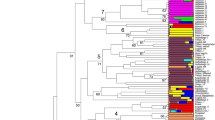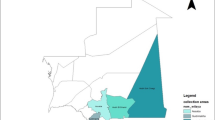Abstract.
Cassava (Manihot esculenta) is an allogamous, vegetatively propagated, Neotropical crop that is also widely grown in tropical Africa and Southeast Asia. To elucidate genetic diversity and differentiation in the crop's primary and secondary centers of diversity, and the forces shaping them, SSR marker variation was assessed at 67 loci in 283 accessions of cassava landraces from Africa (Tanzania and Nigeria) and the Neotropics (Brazil, Colombia, Peru, Venezuela, Guatemala, Mexico and Argentina). Average gene diversity (i.e., genetic diversity) was high in all countries, with an average heterozygosity of 0.5358 ± 0.1184. Although the highest was found in Brazilian and Colombian accessions, genetic diversity in Neotropical and African materials is comparable. Despite the low level of differentiation [Fst(theta) = 0.091 ± 0.005] found among country samples, sufficient genetic distance (1-proportion of shared alleles) existed between individual genotypes to separate African from Neotropical accessions and to reveal a more pronounced substructure in the African landraces. Forces shaping differences in allele frequency at SSR loci and possibly counterbalancing successive founder effects involve probably spontaneous recombination, as assessed by parent-offspring relationships, and farmer-selection for adaptation.




Similar content being viewed by others
References
Akano A, Barrera E, Mba C, Dixon AGO, Fregene MA (2002) Genetic mapping of a dominant gene conferring resistance to the cassava mosaic disease (CMD). Theor Appl Genet 105:521–525
Baverstock PR, Moritz C (1996) Project design. In: Hillis DM, Moritz C, Mable BK (eds) Molecular systematics. Sinauer Associates, Sunderland, Massachusetts, pp 17–27
Beeching JR, Marmey P, Gavalda MC, Noirot M, Haysom HR, Hughes MA, Charrier A (1993) An assessment of genetic diversity within a collection of cassava (Manihot esculenta Crantz) germplasm using molecular markers. Ann Bot 72:515–520
Bertin P, Gregoire D, Massart S, de Froidmont D (2001) Genetic diversity among European cultivated spelt revealed by microsatellites. Theor Appl Genet 102:148–156
Bowcock AM, Ruiz-Linares A, Tomfohrde J, Mich E, Kidd JR, Cavalli-Sforza LL (1994) High resolution of human evolutionary trees with polymorphic microsatellites. Nature 368:455–457
Chavarriaga-Aguirre P, Maya MM, Bonierbale MW, Kresovich S, Fregene MA, Tohme J, Kochert G (1998) Microsatellites in cassava (Manihot esculenta Crantz): discovery, inheritance and variability. Theor Appl Genet 97:493–501
Chavarriaga-Aguirre P, Maya MM, Tohme J, Duque MC, Iglesias C, Bonierbale MW, Kresovich S, Kochert G (1999) Using microsatellites, isozymes and AFLPs to evaluate genetic diversity and redundancy in the cassava core collection and to assess the usefulness of DNA-based markers to maintain germplasm collections. Mol Breed 5:263–273
Cock JH (1985) Cassava: new potential for a neglected crop. Westview, London
Dellaporta SL, Wood J, Hicks JR (1983) A plant DNA minipreparation: version II. Plant Mol Biol Rep 1:19–21
Donini P, Stephenson P, Bryan GJ, Koebner RMD (1998) The potential of microsatellite markers for high throughput genetic diversity assessment in wheat and barley. Gene Resour Crop Evol 45:415–421
Doyle M, Pujol B, Elias M (2001) Ecology and genetics of populations of cassava managed by Amazonian Amerindians: or, how to maximize the benefits and minimize the costs of outcrossing in a vegetatively propagated crop. In: Fauquet C, Taylor NN (eds) Proc 5th Int Scientific Meeting of the Cassava Biotechnology Network, Danforth Plant Science, St. Louis, Missouri (in press)
Efron B (1982) The jackknife, the bootstrap and other resampling plans. NSF-CBMS Regional Conference Series in Applied Mathematics, Monograph 38. Society for Industrial and Applied Mathematics (SIAM), Philadelphia, Pennsylvania
Elias M, Panaud O, McKey DB, Robert T (2000) Traditional cultivation of cassava among Amerindians: consequences on genetic diversity assessed with AFLP markers. In: Carvalho LJCB, Thro AM, Vilarinhos A (eds) Cassava biotechnology; IV Int Sci Meeting of the Cassava Biotechnology Network. Empresa Brasileira de Pesquisa Agropecuária (EMBRAPA), Brasília, DF, pp 111–117
Eyre-Walker A, Gaut RL, Hilton H, Feldman D, Gaut B (1998) Investigation of the bottlenecks leading to the domestication of maize. Proc Natl Acad Sci USA 95:4441–4446
FAO (Food and Agriculture Organization of the United Nations) (2000) Food outlook, Rome
Fregene MA, Vargas J, Ikea J, Angel F, Tohme J, Asiedu RA, Akorada MO, Roca WM (1994) Variability of chloroplast DNA and nuclear ribosomal DNA in cassava (Manihot esculenta Crantz) and its wild relatives. Theor Appl Genet 89:719–727
Fregene MA, Bernal A, Duque MC, Dixon AGO, Tohme J (2000) AFLP analysis of African cassava (Manihot esculenta Crantz) germplasm resistant to the cassava mosaic disease (CMD). Theor Appl Genet 100:678–685
Goudet J (1995) FSTAT (version 1.2): a computer program to calculate F-statistics. J Hered 86:485–486
Hershey C, Iglesias C, Iwanaga M, Tohme J (1992) Definition of a core collection for cassava. In: Report of the First Meeting of the International Network for Cassava Genetic Resources, CIAT, Cali, Colombia, 18–23 August 1992. International Crop Network Series No. 10. International Plant Genetic Resources Institute (IPGRI), Rome, pp 145–156
Jennings DL (1976) Breeding for resistance to African cassava mosaic. In: African cassava mosaic, report of an interdisciplinary workshop held at Muguga, Kenya. International Development Research Centre (IDRC), Ottawa, Canada, pp 39–44
Jones WO (1969) Manioc in Africa. Stanford University Press, Stanford, California
Keeratinijakal V, Lamkey KR (1993) Responses to a reciprocal recurrent selection in BSSS and BSCBI maize populations. Crop Sci 33:73–77
Kimura M, Crow JT (1964) The number of alleles that can be maintained in a finite population. Genetics 49:725–738
Leroy TC, Momtagnon C, Charrier A, Eskes AB (1993) Reciprocal recurrent selection applied to Coffea canephora Pierre. I. Characterization and evaluation of breeding populations and value of intergroup hybrids. Euphytica 67:113–125
Marshall TC, Slate J, Kruuk LEB, Pemberton JM (1998) Statistical confidence for likelihood-based paternity inference in natural populations. Mol Ecol 7:639–655
Mba REC, Stephenson P, Edwards K, Melzer S, Mkumbira J, Gullberg U, Apel K, Gale M, Tohme J, Fregene MA (2001) Simple sequence repeat (SSR) markers survey of the cassava (Manihot esculenta Crantz) genome: towards an SSR-based molecular genetic map of cassava. Theor Appl Genet 101:21–31
Meagher TR (1986) Analysis of paternity within a natural population of Chamaelirium luteum. I. Identification of most-likely male parents. Am Natl 128:199–215
Melchinger AE, Lee M, Lamkey KR, Woodman WL (1990) Genetic diversity for restriction fragment length polymorphisms: relation to estimated genetic effects in maize inbreds. Crop Sci 30:1033–1040
Nei M (1978) Estimation of average heterozygosity and genetic distances from a small number of individuals. Genetics 89:583–590
Olsen K, Schaal B (1999) Evidence on the origin of cassava: phylogeography of Manihot esculenta. Proc Natl Acad Sci USA 96:5586–5591
Olsen K, Schaal B (2001) Microsatellite variation in cassava Manihot esculenta, Euphorbiaceae and its wild relatives: evidence for a southern Amazonian origin of domestication. Am J Bot 88:131–142
Pearsall DM (1992) Agriculture in the low land tropics of the Americas. In: Cowan CW, Watson PJ, Benco N (eds) The origins of agriculture: an international perspective. Smithsonian Institute, Washington, DC, pp 173–205
Quenoille M (1956) Notes on bias in estimation. Biometrika 43:253–260
Roa AC, Maya MM, Duque MC, Allem C, Tohme J, Bonierbale MW (1997) AFLP analysis of relationships among cassava and other Manihot species. Theor Appl Genet 95:741–750
Rogers DJ (1963) Studies on Manihot esculenta Crantz (cassava) and related species. Bull Torrey Bot Club 9:43–54
Rogers DJ (1965) Some botanical and ethnological considerations of Manihot esculenta. Econ Bot 194:769–777
Rohlf FJ (1993) NTSYS-PC numerical taxonomy and multivariate analysis system. Version 1.8 Exeter Publ., Setauket, New York
SAS Institute, Inc (1995) JMP (version 3.1). Cary, North Carolina
Sauer CO (1952) Agricultural origins and dispersals. American Geographical Society, New York, USA
Sauer JD (1993) Historical geography of crop plants: a select roster. (CRC Press, Boca Raton, Florida)
Schaal BA, Olson PD, Prinzie TP, Carvalho LCB, Tonukari J, Hayworth DA (1994) Phylogenetic analysis of the genus Manihot based on molecular markers. In: Roca WM, Thro AM (eds) Proc 1st Scientific Meeting of the Cassava Biotechnology Network, Cartagena, Colombia, 25–28 August 1992 Working Document No. 123. Centro Internacional de Agricultura Tropical (CIAT), Cali, Columbia, pp 106–122
Shull GF (1952) Beginnings of the heterosis concept. In: Gowen JW Heterosis. Iowa Sate College Press, Ames, Iowa, pp 14–48
Takezaki N, Nei M (1996) Genetic distances and reconstruction of phylogenetic trees from microsatellite DNA. Genetics 139:457–462
Thompson EA (1975) The estimation of pairwise relationships. Ann Am Naturalist 128:199–215
Tomes D (1998) Heterosis: performance stability, adaptability to changing technology and the foundation of agriculture as a business. In: Lamkey K, Staub JE (eds) Concepts and breeding of heterosis in crop plants. CSSA Special Publication Number 25. Crop Science Society of America, Madison, Wisconsin
Vekemans X, Lefebvre C (1997) On the evolution of heavy metal tolerant populations in Armeria maritima: evidence from allozyme variation and reproductive barriers. J Evol Biol 10:175–191
Weir BS, Cockerham CC (1984) Estimating F-statistics for the analysis of population structure. Evolution 38:1358–1370
Wright S (1951) The genetic structure of populations. Ann Eugen 15:323–354
Acknowledgements.
We thank Eric Minch, and Xavier Vekemans (Université Libre de Bruxelles, Brussels, Belgium) for their assistance with the computer packages "microsat" and GEN-SURVEY, and for their helpful suggestions. We acknowledge the useful comments from Joe Tohme and Paul Chavariagga-Aguirre (CIAT), Luigi Guarino (IPGRI), Ken Olsen (North Carolina State University), Ryohei Terauchi (Iwate Biotechnology Research Center, Kitakami, Japan) and two anonymous reviewers. We also thank Matthew Raya of the Agricultural Research Institute at Naliendele, Tanzania, for his assistance with field collection. This work was supported in part by the International Program for the Chemical Sciences, Uppsala University, Sweden, and we are grateful to its director Malin Akerbolm for her abiding faith in our application of chemistry to unravel genetic diversity issues.
Author information
Authors and Affiliations
Corresponding author
Additional information
Communicated by H.C. Becker
Rights and permissions
About this article
Cite this article
Fregene, M.A., Suarez, M., Mkumbira, J. et al. Simple sequence repeat marker diversity in cassava landraces: genetic diversity and differentiation in an asexually propagated crop. Theor Appl Genet 107, 1083–1093 (2003). https://doi.org/10.1007/s00122-003-1348-3
Received:
Accepted:
Published:
Issue Date:
DOI: https://doi.org/10.1007/s00122-003-1348-3




